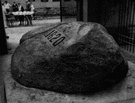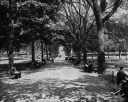The
Making of the 50 States: Massachusetts
Part
1: In the Beginning
Massachusetts was the sixth state to ratify the Constitution. As with other of the 13 Colonies, the land was originally inhabited by Native Americans. (Some historians believe that Norse explorers, perhaps even Leif Erikson himself, visited the area a century ago.)
 The main tribes living in the area were the Alongonquin tribes, specifically the Wampanoag, Massachusett, Nauset, Machian, Nipmuck, Pennacook, and Pocumtuck. Contact with European explorers began in the late 15th Century, with the main results being exchange of goods and diseases. John Cabot explored the area in 1497 and 1498, and sporadic travelers followed during the next century. Bartholemew Gosnold came through in 1602 and named Cape Cod for the fish that were plentiful in the bay. Samuel de Champlain passed by two years later, on his way to bigger and better things in what is now the Midwest. The European diseases were especially deadly to the Native Americans, with an epidemic wiping out 90 percent of coastal tribes by the time the Pilgrims arrived, in 1620. (In fact, Plimoth Plantation was built on the site of a former Native American settlement, Patuxet.)
The main tribes living in the area were the Alongonquin tribes, specifically the Wampanoag, Massachusett, Nauset, Machian, Nipmuck, Pennacook, and Pocumtuck. Contact with European explorers began in the late 15th Century, with the main results being exchange of goods and diseases. John Cabot explored the area in 1497 and 1498, and sporadic travelers followed during the next century. Bartholemew Gosnold came through in 1602 and named Cape Cod for the fish that were plentiful in the bay. Samuel de Champlain passed by two years later, on his way to bigger and better things in what is now the Midwest. The European diseases were especially deadly to the Native Americans, with an epidemic wiping out 90 percent of coastal tribes by the time the Pilgrims arrived, in 1620. (In fact, Plimoth Plantation was built on the site of a former Native American settlement, Patuxet.)
 The first major European settlement in what we now call Massachusetts was, of course, the Pilgrims, who were originally bound for Virginia. Their friendship with the Wampanoag tribe provided instrumental in their survival. Their initial settlement was followed by subsequent settlers, who spread out to other areas. Other important settlements of the following years included Salem (site of the 1692 witch trials), Charlestown, and Boston.
The first major European settlement in what we now call Massachusetts was, of course, the Pilgrims, who were originally bound for Virginia. Their friendship with the Wampanoag tribe provided instrumental in their survival. Their initial settlement was followed by subsequent settlers, who spread out to other areas. Other important settlements of the following years included Salem (site of the 1692 witch trials), Charlestown, and Boston.
In 1630, John Winthrop and a large group of Puritans arrived in Salem, bearing a royal charter to set up the Massachusetts Bay Colony. During the next few decades, a pattern of resistance to royal authority emerged that would vary between an undercurrent and a raging torrent during the next 100 years. In 1684, the British crown revoked the royal charter, and Massachusetts joined the Dominion of New England. Just seven years later, the colony became a Royal Province, which gave it money and support from Great Britain but also subjected it to greater control.
The Massachusetts Bay Colony became a strong presence in trade and in shipping, as the colony continued to grow. The 18th Century brought with it more recognition and more money. Boston by this time was one of the most-recognized names in the world.
The colony was also the site of many "firsts" in the 13 Colonies, including the following:
 the first public park, Boston Common, opened in 1634
the first public park, Boston Common, opened in 1634
- the first free public school, founded in 1635 in Boston
- the first public university, Harvard, founded in Cambridge in 1636
- the first public library, founded in 1653 in Boston
- the first regularly issued newspaper, the Boston News-Letter, begun in 1704.
Next
page > The
Rest of the Story
> Page 1, 2



 The main tribes living in the area were the Alongonquin tribes, specifically the Wampanoag, Massachusett, Nauset, Machian, Nipmuck, Pennacook, and Pocumtuck. Contact with European explorers began in the late 15th Century, with the main results being exchange of goods and diseases.
The main tribes living in the area were the Alongonquin tribes, specifically the Wampanoag, Massachusett, Nauset, Machian, Nipmuck, Pennacook, and Pocumtuck. Contact with European explorers began in the late 15th Century, with the main results being exchange of goods and diseases.  The first major European settlement in what we now call Massachusetts was, of course, the
The first major European settlement in what we now call Massachusetts was, of course, the  the first public park, Boston Common, opened in 1634
the first public park, Boston Common, opened in 1634

